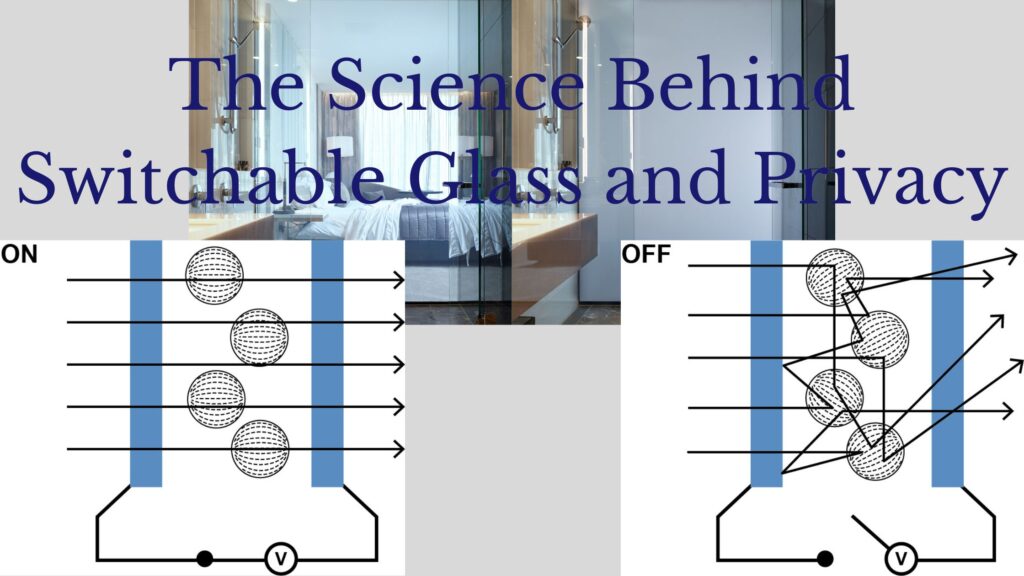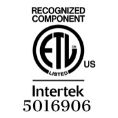What is switchable glass?
Switchable glass, also referred to as smart glass or privacy glass, represents a specialized innovation in glass technology, offering dynamic transparency properties that can be adjusted according to user preferences. With the simple activation of a switch or remote control, users can effortlessly regulate both the amount of light entering a space and the level of privacy maintained.
This technology encompasses various types of switchable glass, each designed with distinct features and tailored applications to suit diverse needs. One such variant is electrochromic switchable glass, which functions through the utilization of an electrochromic film and electric current. When a small voltage is applied, ions migrate within the glass, inducing a change in the reflective properties to control the amount of sunlight and heat that enters a building.
Liquid crystal switchable glass, on the other hand, comprises a layer of liquid crystal molecules sandwiched between two glass sheets. When an electric current is activated, the liquid crystals align, permitting light transmission and rendering the glass transparent. Conversely, deactivating the electric current causes the liquid crystals to scatter light, resulting in opacity. This instantaneous switching capability makes liquid crystal technology ideal for rapid privacy control.
Another notable technology in the realm of switchable glass is the suspended particle device (SPD) technology. SPD solar switchable glass incorporates suspended particles within a film, which can be manipulated to adjust the glass’s opacity. The glass has a bluish-black tint making it ideal for automotive and exterior applications. Upon application of an electric current, the particles align, allowing light to pass through and rendering the glass transparent. Conversely, when the electric current is discontinued, the particles disperse, obstructing light and rendering the glass translucent. With its swift switching speeds and superior optical clarity, SPD technology offers an effective solution for dynamic privacy management.
In summary, switchable glass technologies, including electrochromic, liquid crystal, and SPD, provide versatile solutions for controlling transparency and privacy in various environments. Whether in residential, commercial, or industrial settings, these innovations empower users to tailor their spaces according to their specific preferences and requirements.
Benefits and applications of switchable glass
Switchable glass technology has heralded a transformative era in privacy management, offering a multitude of advantages across various applications:
One of its primary benefits lies in its capacity to enhance privacy. Switchable glass serves as an efficient solution for preserving privacy in both residential and commercial environments. With the ability to seamlessly transition between transparent and opaque states, users can swiftly establish private areas or expand spaces to embrace abundant natural light.
Moreover, switchable glass enables precise control over daylight and glare. By modulating the glass’s transparency, users can effectively regulate the influx of natural light, thereby mitigating glare and fostering a more comfortable ambiance conducive to productivity and relaxation.
In addition to its role in privacy and lighting control, switchable glass contributes significantly to energy efficiency. By harnessing its switchable properties, occupants can curtail reliance on artificial lighting sources, thereby reducing energy consumption. Similarly, switchable glass aids in minimizing heat gain from sunlight, thus optimizing thermal comfort and promoting sustainable building practices.
Furthermore, switchable glass serves as a pivotal component in enhancing security measures. By acting as a privacy barrier and obscuring views of valuable assets, it fortifies the safeguarding of sensitive information and belongings. Beyond its functional benefits, switchable glass also offers designers unparalleled creative freedom, enabling the integration of visually striking architectural elements that elevate the aesthetic appeal of interiors.
In essence, switchable glass technology transcends mere privacy control, encompassing a diverse array of advantages ranging from energy efficiency to enhanced security and aesthetic enrichment. Its versatility and adaptability render it indispensable in modern architectural and design endeavors, empowering users to craft spaces that seamlessly blend functionality with sophistication.
The privacy factor
One of the primary reasons for the widespread adoption of switchable glass is its ability to ensure privacy. By switching to opaque mode, the glass acts as an effective visual barrier, preventing anyone from seeing inside the enclosed space. This feature is particularly valuable in areas where privacy is paramount, such as conference rooms, healthcare facilities, and residential bathrooms.
Switchable glass provides a seamless transition between privacy mode and transparent mode. Whether it’s a touch of a button or a voice command, users can instantly transform the glass from an opaque state to a clear, transparent state, allowing light to pass through and opening up the space.
The science behind switchable glass
Switchable glass technology is a sophisticated interplay of materials and components, each contributing to its remarkable versatility and functionality. Delving into the science behind this innovation unveils the intricate mechanisms driving its switchable nature.
At the core of switchable glass are the materials and components that define its operation. Electrochromic switchable glass typically comprises a transparent conductive coating, an electrochromic film, and an ion storage layer. In contrast, liquid crystal switchable glass integrates liquid crystal molecules, transparent conductive coatings, and alignment layers. Meanwhile, SPD switchable glass employs suspended particles within a film, nestled between two layers of glass, to achieve its transformative capabilities.
The switchable properties of the glass hinge on molecular changes and the application of electrical currents. In electrochromic and liquid crystal technologies, the manipulation of electric charges or the alignment of liquid crystal molecules triggers alterations in transparency. Conversely, in SPD technology, the introduction or removal of an electric current prompts a change in the alignment of suspended particles, thereby influencing the translucency of the glass.
Understanding the intricate chemistry and physics underpinning switchable glass underscores the depth of innovation driving its functionality. Through precise manipulation of materials and harnessing the power of electrical currents, switchable glass technology opens doors to a myriad of applications, from enhancing privacy to optimizing energy efficiency. Truly, the science behind switchable glass epitomizes the marriage of complexity and ingenuity, paving the way for a brighter, more adaptable future in architectural and design landscapes.

Research and advancements
The realm of switchable glass technology is in a perpetual state of evolution, marked by continuous research and experimentation aimed at enhancing performance and broadening applications. Scientists and innovators are at the forefront of this dynamic field, exploring novel materials, refining manufacturing processes, and pioneering innovative approaches to control switching mechanisms.
Ongoing studies and experiments are pivotal in driving advancements in switchable glass technology. Researchers are focused on improving the efficiency and durability of switchable glass by delving into new electrochromic materials, fine-tuning liquid crystal formulations, and scrutinizing the behavior of suspended particles in SPD technology. Through ongoing experiments, the goal is to optimize switching speed, enhance optical clarity, and extend the lifespan of switchable glass, ensuring it meets the rigorous demands of diverse applications.
Looking ahead, the future of switchable glass teems with exciting prospects and untapped potential. Researchers envision groundbreaking developments, such as the advent of flexible switchable glass, paving the way for dynamic architectural designs and innovative display solutions. Integration with smart home systems is also on the horizon, promising seamless control and automation of switchable glass applications, enhancing convenience and user experience.
Moreover, researchers are exploring the possibility of developing switchable glass that can dynamically change colors or adjust transparency levels in response to external factors, such as sunlight intensity or user preferences. These advancements hold the promise of further enhancing the functionality and versatility of switchable glass technology, opening new avenues for its application across various industries and settings.
In essence, the journey of switchable glass technology is characterized by relentless innovation and boundless potential, offering a glimpse into a future where glass becomes more than just a passive component but a dynamic and adaptive element in our built environment.
In conclusion, switchable glass technology has redefined the way we control privacy, light, and aesthetics, with immense potential to revolutionize architecture and create sustainable environments. By unraveling the science behind switchable glass, we gain insight into its transformative capabilities and the boundless possibilities it holds for the future.





